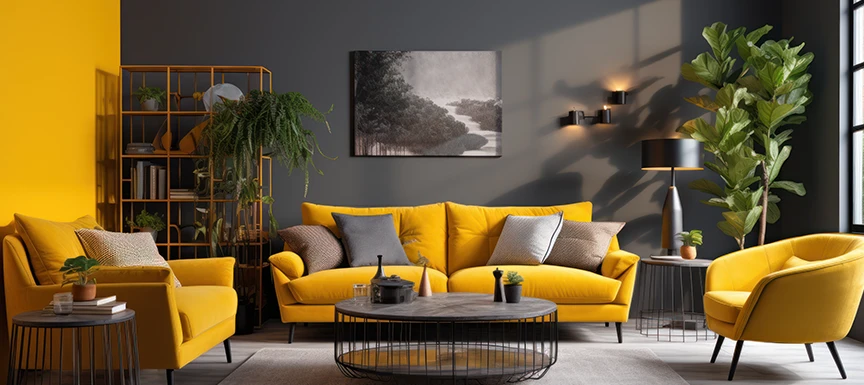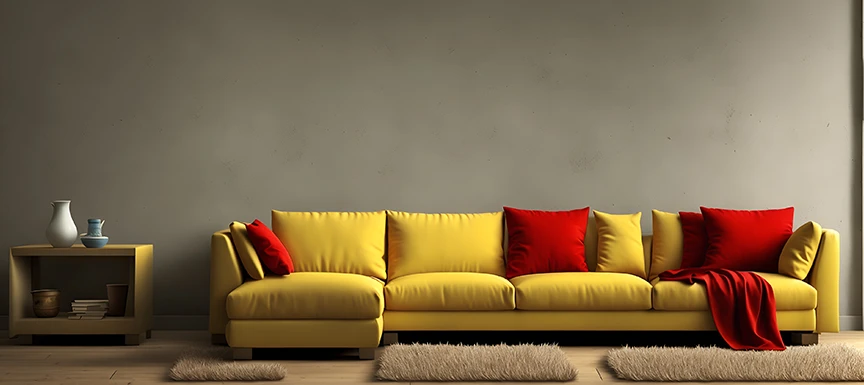
Sitting Room Colour Combination: Discover the Perfect Palette for Your Space
Choosing suitable Colours is essential to set the mood of a space. The living room, being the place where you relax and receive guests, must feature hues that reflect your personal taste while enhancing the appearance of the area. In the search for Colour combinations, this article examines the importance of Colour in interior decoration, fundamental concepts of sitting room Colour combination, considerations when choosing Colours for an area, and tips for creating a harmonious space.
Understanding the Basics of Colour Theory

Colour theory is a crucial aspect of design that examines the way various Colours combine to create pleasing arrangements. The primary instrument for this study is the Colour wheel, which appears as a circular diagram displaying primary Colours such as red, blue, and yellow; secondary Colours created by blending primaries; and tertiary Colours resulting from mixing one secondary with a primary Colour. The wheel aids in understanding various Colour schemes.
Impressions Kashmir range of Colours that go well together are found opposite each other on the Colour wheel, creating a sharp contrast, while Colours beside one another blend gently. Applying different tones of the same Colour results in an elegant look. Tertiary Colours allow for nuanced combinations.
For a sitting room Colour combination, considering both warm and cool Colours, along with the emotions that Colours evoke in our thoughts, is crucial for a proper grasp of Colour theory. This knowledge aids designers and homeowners alike in selecting harmonious Colour schemes for rooms or spaces.
Factors to Consider When Choosing a Colour Palette

Begin by considering the size of the space and the amount of natural light it receives, as these factors can influence how you perceive different hues. Large spaces can take bold Colours, whereas smaller rooms benefit from gentle tones, which give the illusion of more space.
While considering sitting room Colour ideas, think about the room's purpose and how you want it to feel. Calm areas may benefit from gentle Colours, whereas vibrant tones can make gathering spaces feel energetic. Consider the existing furniture and decorations. Coordinating or contrasting them can alter the overall aesthetic appeal.
The sensation you want to create with your sitting room paint Colour ideas is significant. Colours like red and yellow make a cozy ambiance, while blue and green Colours offer tranquility. Ultimately, the Colours you choose are shaped by your personal preferences and what's common in your culture, ensuring that the chosen hues represent your unique taste and inclinations.
Also Read: Give Your Hall a Designer Look with these Tips and Tricks
Different Types of Sitting Room Colour Combinations

1. Monochromatic Sitting Room Colour Combinations
In a sitting room Colour design where there is just a single Colour, the primary Colour holds much significance. Varying shades and tones of that same Colour contribute to creating an elegant appearance, ensuring all elements harmonize nicely. This method provides a sense of calm while also maintaining visual appeal. It is an excellent choice for those desiring their living room to remain timeless and attractive.
2. Complementary Sitting Room Colour Combinations
Choosing Colours from opposite sides of the Colour wheel creates sitting room Colour schemes using complements. This results in a bold contrast that adds vibrancy and light to the room. Ideal for those who enjoy creating a powerful impact, combining elements in a manner that captures attention and adds a sense of thrill to the space.
3. Analogous Sitting Room Colour Combinations
Impression Ultra HD Colour arrangements that are analogous pick Colours that sit close on the Colour wheel, making a blend that is soft and harmonious for an outcome that's subtle. Such combinations of similar Colours work well if someone wishes their living room to display matching shades yet not too vibrant, resulting in an inviting and pleasant visual atmosphere.
Tips for Creating a Cohesive and Balanced Colour Scheme

To create an attractive and uniform Colour scheme in your living room, begin with a primary Colour from the Nerolac Beauty Little Master Sheen range of emulsions to set the atmosphere. Then, select complementary Colours for secondary elements and incorporate small dashes of various shades to add visual appeal. Ensure that warm and cool Colours are balanced in the room to avoid an overpowering or monotonous atmosphere.
Experiment with the sitting room Colour combination from your chosen Colour palette to add dynamism. Apply the 60-30-10 principle, allocating 60% of the area to your primary Colour, dedicating 30% to a secondary tone, and reserving only 10% for accent hues.
Popular Sitting Room Colour Schemes

1. Sitting Room Colour Combination with Neutral
Living rooms always look good with neutral Colours like white, gray, and natural tones. These simple Colours create a timeless backdrop that allows you to easily personalize the space with various pieces of furniture and decorative items. Neutrals create an ambiance of tranquility and sophistication, suitable for those who appreciate understated elegance and are adaptable to various designs.
2. Sitting Room Colour Combination with Bold
Vivid Colours such as navy blue, vibrant green, and rich red infuse the living room with vitality and a pronounced fashion sense. These intense hues suit those desiring a spirited and confident decor, transforming the space into one that buzzes with dynamism.
3. Sitting Room Colour Combination with Pastel
Gentle Colours and light tones, like soft green, pale pink, and sky blue, create a peaceful and calm atmosphere. These pastel shades are excellent for smaller spaces as they help the room appear open and fresh, creating a relaxing sitting space. The mix of Colours is pleasant for those who prefer their house to be soothing and soft.
How to Incorporate Accent Colours into Your Sitting Room

To give your living room more personality and feeling, purposefully select some accent Colours. For efficient sitting room Colour schemes, use bright Colours in things like pillows, artwork, rugs, and add little touches to catch the eye and make the space look better.
Consider applying the 10% guideline, allocating about one-tenth of a space's overall hue to accent Colours. This approach helps achieve equilibrium and ensures that everything appears unified while preventing the dominant shades from overwhelming. Choose accent Colours that complement or contrast with the primary ones, creating an engaging interplay.
Also Read: Luxurious Hall Room Colours Shades That Transform Your Space
Choosing Wall Paint Colours and Coordinating with Furniture and Decor

Selecting suitable sitting room paint Colour ideas for the walls that complement your furniture and decor is essential. First, observe the furniture you possess - if its tones are neutral, numerous paint choices can suit it well, However, with brightly Coloured furnishings, opt for more subtle wall Colours to achieve harmony in appearance.
Attempt to apply samples of paint in various lighting conditions so you can see if the shade you choose complements the room's natural and artificial light. Align wall Colours with primary tones present in your furnishings and decor to achieve a harmonious appearance.
To make the room more captivating, consider putting a wall that has a unique pattern or distinct Colour to highlight one section without overwhelming the entire area. Should there be hesitation, opting for neutral sitting room Colour ideas on walls is advisable as they remain timeless and complement various furniture and decor styles. The primary goal is to discover a proper balance that enhances the overall design, making your living room an integrated and inviting space.In Conclusion
The mix of Colours in your living room reflects your individual style and creates the atmosphere of the space. By understanding sitting room Colour design and exploring numerous Colour schemes, you can design a living space that is visually pleasing, feels inviting, and tailored to your preferences.
When selecting Colours such as neutral, bold, or gentle for your living room, it's crucial to maintain balance and good coordination so that the area truly reflects your personality.
Nerolac Paints, a leading paint company in India offers a wide range of wall paint colours & painting services & solutions for homes & offices.

Colour Combination for Walls: 10 Beautiful House Colour Combination Ideas In 2023
A Guide To Trending Colour Combinations For Walls With Images
12 Stylish Green Colour Combinations and Photos
Green Colour Combinations
What Colours Match with Blue? 14 Colour Combinations with Blue for Your Home
Blue is a universally popular colour for décor and design
-
Recent Blogs
- Unlocking the Beauty of Simple Geometric Wall Paint: A Guide to Effortless Design
- Transforming your Space with Takcher Paint Design: A Guide to Texture Painting Walls
- Sitting Room Colour Combination: Discover the Perfect Palette for Your Space
- Revamp Your Kitchen with These Bright Wall Colors: Transforming Dull Spaces
- Kitchen Partition Designs that Enhance Your Living and Dining Space
Get in Touch
Looking for something else? Drop your query and we will contact you.
Get in Touch
Looking for something else? Drop your query and we will contact you.
Get in Touch
Looking for something else? Drop your query and we will contact you.


